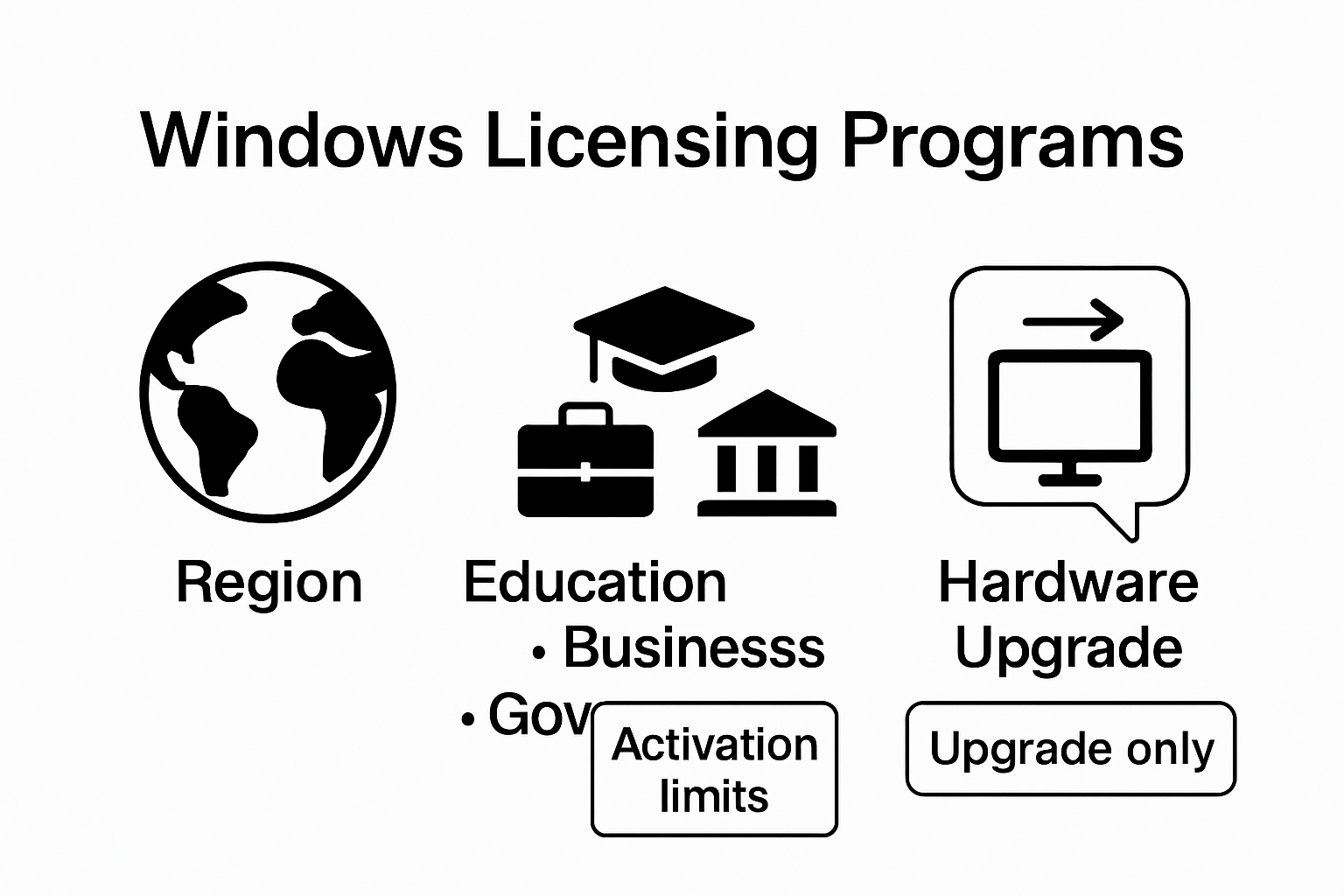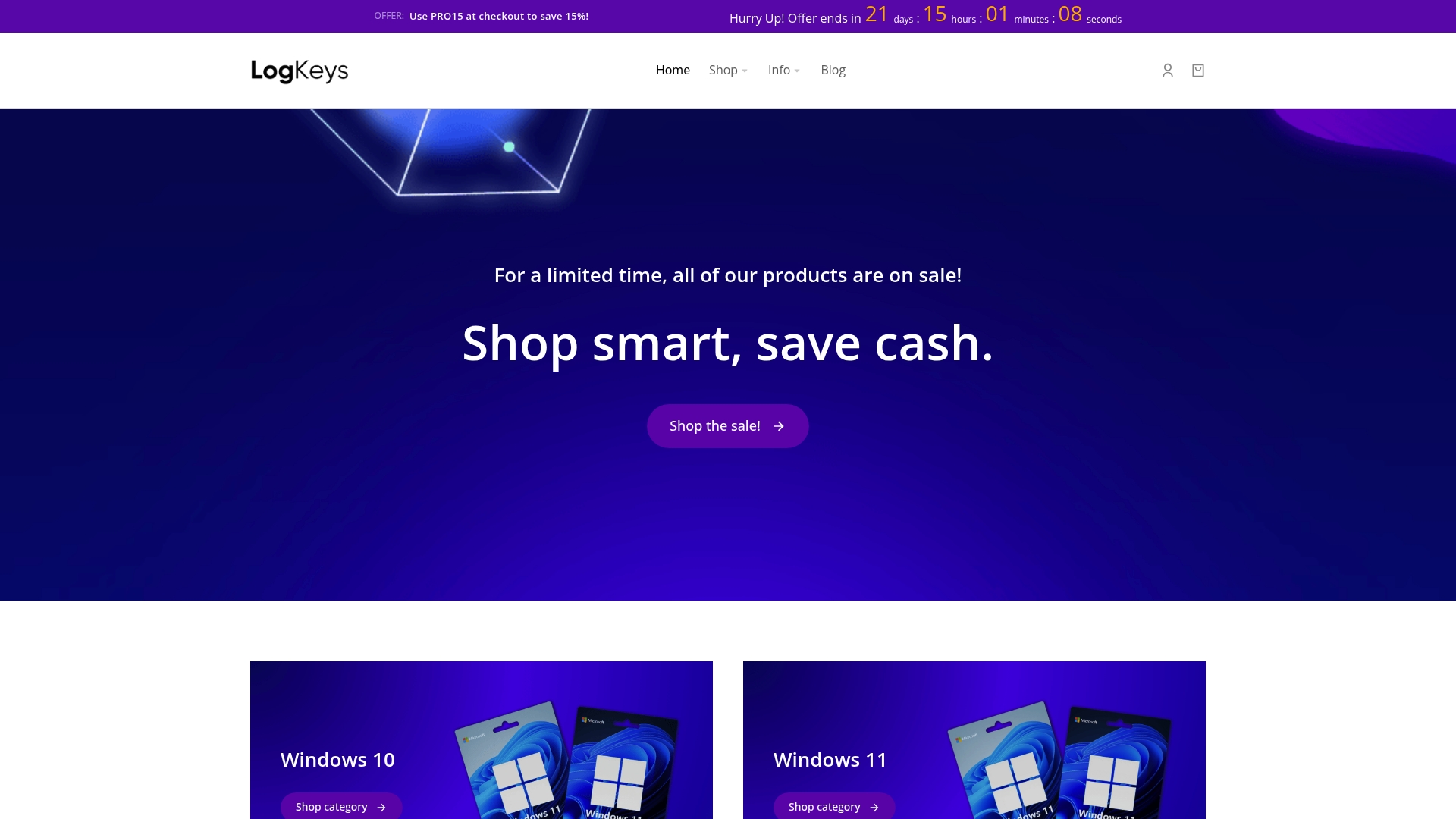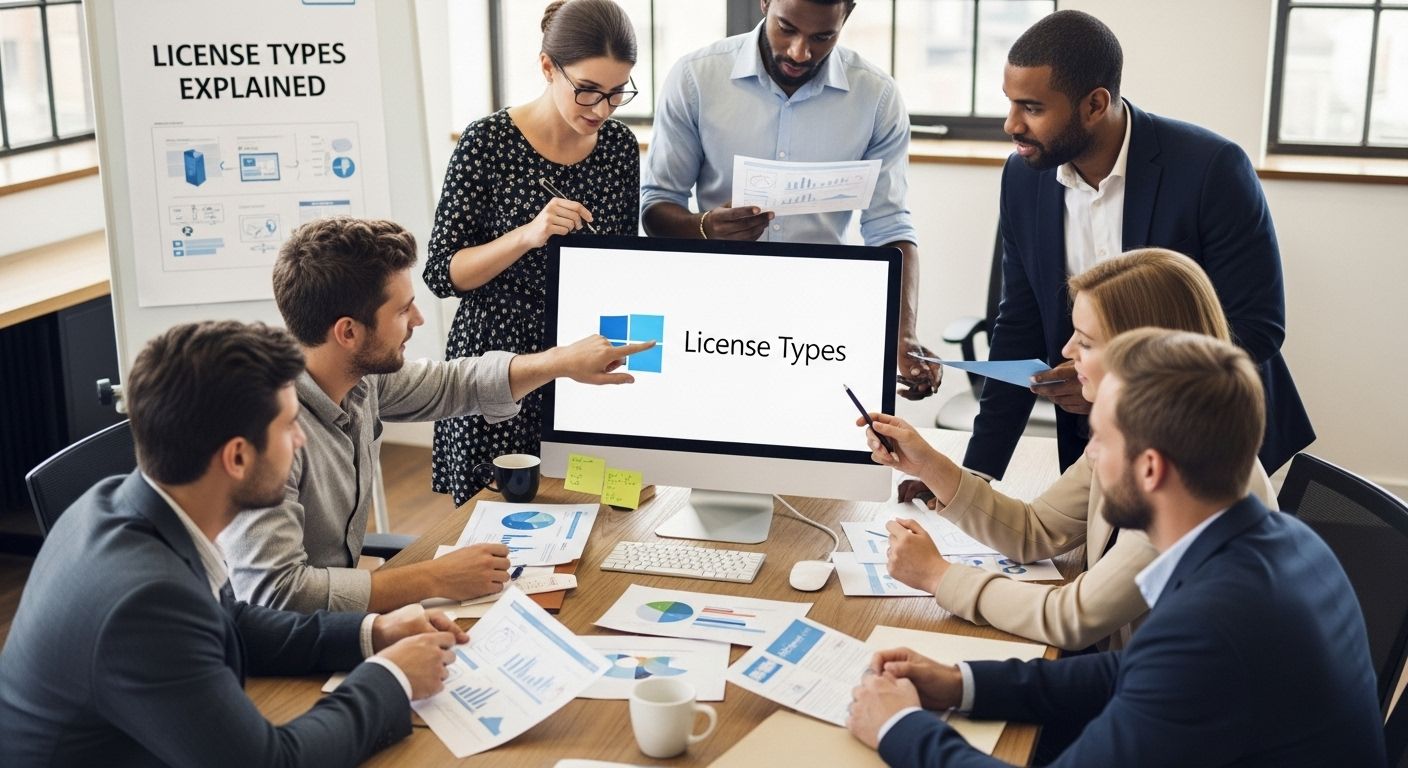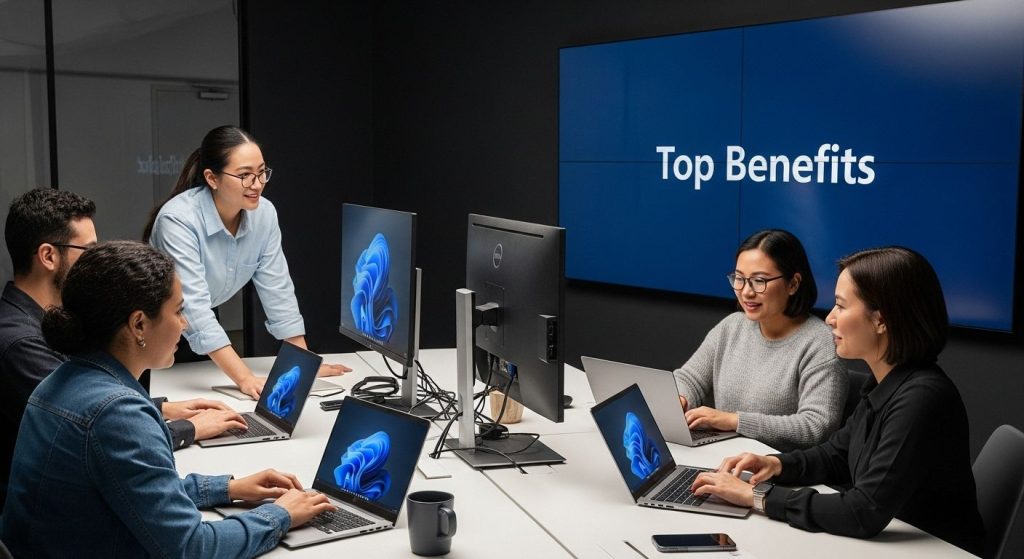Choosing the right Windows license types can seem simple at first. Yet there are more options than you might guess and the rules can get confusing fast. Get this. Retail licenses let you move your Windows to a new computer whenever you upgrade, but OEM licenses are tied to the first device you install them on forever. Most people assume the cheapest license is always the best pick. That is a mistake that can cost a lot in the long run.
Table of Contents
ToggleQuick Summary
| Takeaway | Explanation |
|---|---|
| Choose between Retail and OEM licenses | Retail licenses allow for transfer between devices, while OEM are tied to original hardware and less flexible. |
| Understand your personal versus professional needs | Home users typically need Windows Home, while professionals benefit from Windows Pro or Enterprise editions for advanced features. |
| Beware of unauthorized and counterfeit licenses | Purchasing from unauthorized sources can lead to security risks and software instability. Always buy from official retailers. |
| Evaluate the total cost of ownership | Consider long-term costs and support rather than solely the initial price to avoid hidden expenses. |
| Recognize regional licensing variations | Licensing terms vary globally; understand local regulations and potential impact on upgrades and activation. |
Understanding the Main Windows License Types
Windows licenses are legal agreements that define how users can install and use Microsoft’s operating systems. These licenses are critical for ensuring software compliance and accessing the full range of features in Windows operating systems.
Retail vs. OEM License Types
Two primary Windows license categories dominate the market: retail and OEM licenses. Learn more about Windows activation methods to understand the nuances between these license types. Retail Licenses provide the most flexible option for users. According to the University of Hawaii’s software licensing information, a retail license allows users to transfer the software to a different computer, making it an ideal choice for individuals who frequently upgrade their hardware. These licenses typically come with direct Microsoft support and can be transferred between devices, giving users maximum flexibility.
OEM (Original Equipment Manufacturer) Licenses are typically less expensive and tied to the specific hardware they are initially installed on. These licenses are primarily sold to computer manufacturers and are pre-installed on new devices. Unlike retail licenses, OEM licenses are permanently linked to the original computer and cannot be transferred to a new machine.
Below is a comparison table summarizing the key features and differences between Retail and OEM Windows licenses to clarify which option might be better for different types of users.
| Feature | Retail License | OEM License |
|---|---|---|
| Transferable | Yes (move to new device) | No (tied to original hardware) |
| Cost | Higher | Lower |
| Included Support | Direct from Microsoft | Usually from device manufacturer |
| Target Buyers | Individuals, upgraders | PC builders, manufacturers |
| Pre-installed on Devices | No | Yes |
| Flexibility | High | Low |
Windows License Editions and Access
Microsoft offers multiple Windows license editions to cater to different user needs. Client Access Licenses (CALs) play a crucial role in business and enterprise environments. As the University of Hawaii notes, some editions like Windows 10 Education are essentially equivalent to Enterprise versions, with subtle differences based on the intended environment.
The main Windows license editions include:
- Windows Home: Designed for personal and home computer users
- Windows Pro: Offers additional features for professionals and small businesses
- Windows Enterprise: Provides advanced security and management tools for large organizations
- Windows Education: Tailored specifically for academic institutions
Each edition comes with unique features and licensing terms, allowing users to choose the most appropriate option for their specific needs. The complexity of Windows licensing underscores the importance of understanding the specific requirements and limitations of each license type before making a purchase.
To help you quickly compare the main Windows license editions and their intended audiences, refer to the following summary table.
| Edition | Intended Audience | Key Features/Notes |
|---|---|---|
| Windows Home | Personal/Home users | Basic features for general tasks, affordability |
| Windows Pro | Professionals/Small businesses | Advanced security, Remote Desktop, domain join support |
| Windows Enterprise | Large organizations/Enterprise | Centralized management, advanced security, bulk licensing |
| Windows Education | Academic institutions | Enterprise-level features, tailored for education |
Ultimately, selecting the right Windows license involves carefully evaluating your personal or organizational requirements, budget constraints, and long-term computing needs. By understanding the distinctions between retail, OEM, and various Windows editions, users can make informed decisions that provide the best balance of functionality, support, and cost-effectiveness.
Choosing the Right License for Your Needs
Selecting the appropriate Windows license requires a strategic approach that considers your specific computing requirements, budget constraints, and long-term usage plans. Understanding the nuanced differences between license types can help you make an informed decision that maximizes value and functionality.
Personal vs. Professional License Requirements
Personal users and professionals have distinctly different licensing needs. Learn more about Windows activation strategies to help determine the most suitable option for your scenario.
For individual users, Windows Home edition typically provides sufficient features for everyday computing tasks like web browsing, document creation, and media consumption. These licenses are more affordable and designed for personal use. According to Microsoft’s licensing documentation, personal licenses offer essential security updates and basic system functionality.
Professional and business users, however, require more advanced features. Windows Pro and Enterprise editions offer enhanced capabilities such as advanced security protocols, remote desktop access, domain joining, and comprehensive management tools. Volume licensing information from Wikipedia highlights that organizations can leverage bulk licensing options to reduce per-device costs and simplify software management.
Evaluating License Flexibility and Cost
The flexibility of a Windows license plays a crucial role in determining its overall value. Retail licenses provide the most adaptability, allowing users to transfer the software between devices. This makes them ideal for individuals who frequently upgrade their hardware or replace computers.
OEM licenses, while typically less expensive, come with significant limitations. These licenses are permanently tied to the original hardware and cannot be transferred to a new machine. For budget-conscious users who do not anticipate frequent hardware changes, OEM licenses can offer substantial cost savings.
Businesses and educational institutions should carefully assess their specific requirements. Enterprise and Education editions offer specialized features tailored to organizational needs. These licenses often include advanced security features, centralized management tools, and specific compliance requirements.
Key considerations when choosing a Windows license include:
- Budget constraints: Compare the upfront and long-term costs of different license types
- Hardware upgrade frequency: Determine whether transferability is important
- Specific feature requirements: Identify which advanced features are necessary for your work or personal use
- Support needs: Evaluate the level of technical support provided with each license type
Ultimately, the right Windows license is a personalized choice that balances functionality, cost, and individual or organizational computing needs. By carefully analyzing your specific requirements and understanding the nuances of different license types, you can select a Windows license that provides optimal performance and value.
Regional Differences in Windows Licensing
 Windows licensing is not a one-size-fits-all approach, with significant variations existing across different regions and organizational contexts. Understanding these regional nuances is crucial for ensuring compliance and obtaining the most appropriate licensing solution. Explore regional activation strategies to navigate the complex landscape of Windows licensing.
Windows licensing is not a one-size-fits-all approach, with significant variations existing across different regions and organizational contexts. Understanding these regional nuances is crucial for ensuring compliance and obtaining the most appropriate licensing solution. Explore regional activation strategies to navigate the complex landscape of Windows licensing.
Licensing Variations Across Geographical Boundaries
Microsoft’s licensing strategies differ substantially between regions, reflecting local market conditions, economic factors, and legal requirements. According to Microsoft’s Open Value program documentation, companies can share licensing agreements within defined regional boundaries, such as North America encompassing both the United States and Canada.
In academic environments, licensing takes on unique characteristics. The University of Hawaii’s licensing information reveals that educational institutions often receive specialized licensing options. For instance, Windows 10 Education is essentially equivalent to the Enterprise version, but tailored specifically for school environments. This demonstrates how Microsoft customizes licensing to meet specific institutional needs.
Upgrade and Activation Limitations
Regional restrictions can significantly impact software upgrades and activation processes. Duke University’s Office of Information Technology highlights an important consideration: many institutional licenses are upgrade-only, requiring an existing eligible operating system for legal implementation.
Key regional licensing considerations include:
- Geographical restrictions: Some license types have limited transferability across international borders
- Compliance requirements: Legal and regulatory differences affect licensing terms
- Pricing variations: License costs can fluctuate based on local economic conditions
- Support availability: Technical support and service levels may vary by region
Businesses and individuals must carefully navigate these regional complexities. Volume licensing programs, educational discounts, and regional partnership agreements can offer significant advantages, but they require thorough understanding of local regulations and Microsoft’s specific licensing frameworks.
Ultimately, successful Windows licensing depends on a comprehensive approach that considers geographical, institutional, and individual requirements. By understanding the nuanced differences in regional licensing strategies, users can make informed decisions that maximize software value while ensuring full legal compliance.
Common Mistakes to Avoid When Buying
Purchasing a Windows license can be complex, with numerous potential pitfalls that could compromise your software investment. Understanding these common mistakes helps users make informed decisions and protect themselves from costly errors.
Falling for Unauthorized and Counterfeit Licenses
One of the most critical mistakes buyers make is purchasing licenses from unauthorized sources. Check out our guide on safe Windows activation to understand the risks associated with unauthorized software.
Counterfeit or pirated licenses pose significant risks beyond legal complications. These unauthorized licenses often lack critical security updates, leaving your system vulnerable to malware and cyber threats. Microsoft explicitly warns against using non-genuine software, which can result in:
- Automatic system notifications about unauthorized Windows installation
- Inability to receive critical security updates
- Potential system instability
- Risk of permanent software deactivation
Misunderstanding License Transfer and Usage Rights
Users frequently misunderstand the nuanced transfer and usage rights associated with different Windows license types. Retail and OEM licenses have dramatically different permissions that can significantly impact long-term usability.
Retail licenses offer maximum flexibility, allowing users to transfer the software between devices. In contrast, OEM licenses are permanently tied to the original hardware. This limitation means that if you upgrade your computer, you cannot simply transfer the OEM license to the new machine.
Additional critical considerations include:
- Verifying license authenticity: Always purchase from authorized Microsoft partners
- Understanding edition-specific limitations: Each Windows edition has unique feature restrictions
- Checking hardware compatibility: Ensure your system meets minimum requirements for the chosen license
- Reviewing update and support terms: Different licenses provide varying levels of technical support
Overlooking Total Cost of Ownership
Buyers often focus solely on the initial purchase price without considering the long-term implications. A cheaper license might seem attractive initially but could result in higher costs through limited features, reduced support, or frequent manual updates.
Professional and Enterprise editions, while more expensive, often provide comprehensive features that can reduce overall IT management costs. These editions typically include:
- Advanced security features
- Centralized management tools
- Regular feature and security updates
- Comprehensive technical support
Careful evaluation of your specific needs is crucial. A home user might find the basic Windows Home edition sufficient, while a business professional might require the advanced capabilities of Windows Pro or Enterprise.
Ultimately, avoiding these common mistakes requires thorough research, understanding your specific requirements, and purchasing from reputable sources. By being informed and cautious, you can select a Windows license that provides optimal value, security, and functionality for your unique computing needs.
Frequently Asked Questions
What are the key differences between Retail and OEM Windows licenses?
Retail licenses offer the flexibility to transfer the software to new devices, while OEM licenses are tied permanently to the first hardware they are installed on and cannot be transferred.
What are the main Windows license editions available and their target audiences?
The main editions include Windows Home for personal users, Windows Pro for professionals and small businesses, Windows Enterprise for large organizations, and Windows Education for academic institutions. Each edition contains features tailored for their intended users.
How do regional differences affect Windows licensing?
Licensing terms can vary based on geographical location, affecting transferability, compliance requirements, and pricing. This highlights the importance of understanding local regulations when selecting a Windows license.
What are common mistakes to avoid when purchasing a Windows license?
Common mistakes include buying unauthorized or counterfeit licenses, misunderstanding the transfer rights of different licenses, and overlooking the total cost of ownership, which can lead to higher long-term expenses.
Stop Worrying About Windows License Choices—Get Clarity and Instant Activation
Confused about retail versus OEM licenses, worried about getting locked out after a hardware upgrade, or afraid of wasting money on unauthorized keys? If you want genuine flexibility and peace of mind, you need an official solution that supports both your wallet and your device.

At Logkeys.com, you can skip the risk of fake products and the stress of compliance. Our secure Windows license keys are fully transferable and come with 24/7 support, so you always stay protected and up to date. Ready to simplify your activation and stop guessing about license types? Visit Logkeys.com now for instant delivery and complete transparency—because every device deserves a genuine start.











